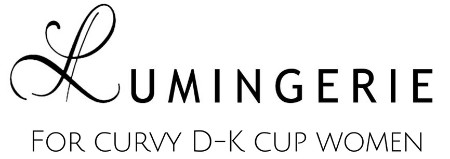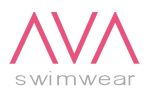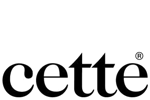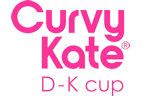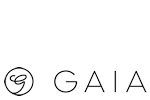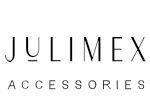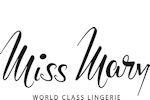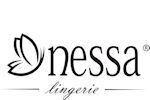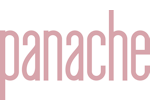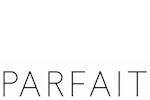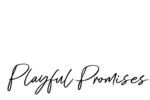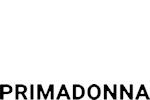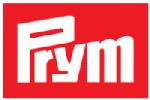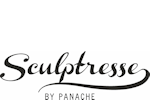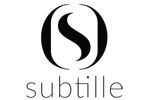Bra Fitting Guide
Lumingerie - bra fitting guide
When trying on a bra, make sure that the bra is a correct fit.
A wrong size bra will start to feel painful during the day. You might have to continuosly adjust bra and breasts
to feel some relief. The wrong size bra give proper support to the breast.
Keep in mind three key points when you are trying on a new bra: the right band lenght, the right cup size and right shoulder
strap tightness. Correct bra size and fit is especially important for large breasts.
Don't know your bra size? Try out our bra size calculator.
Here are our tips to a satisfactory fit:
The right size band
Always check first that the bra band lenght is correct: tight enough, but not too tight. Bend forward at the waist, slip on the bra and hook it. Choose a bra that fits when secured on the outermost hook. You should be able to comfortably run you finger underneath and along the band. If the bra back rides up, the band is too big. Go down a band size, but please note that when the band size decreases, you should increase the cup size, ie try the sister size.
When trying on a bra, always put them on the outermost hook. This leaves you room for tightening as the bra can loosen in use. If you hook the bra straight to the tightest position the band is too big.
When you lift your hands up and the bra comes off the chest and breast tissue drops under the wire, the band size is too large and the cup size too small. The bra doesn´t provide any support. In addition you will have to correct the position of the bra multiple times during the day. The right size bra sits againts the rib cage beautifully, even if you lift your arms and move around.
Tip: To check if the circumference is too large. Put your hand underneath the band behind your back. Then, lift the band away from your back. If you can easily lift the band over a palm-width from our body, go down a band size
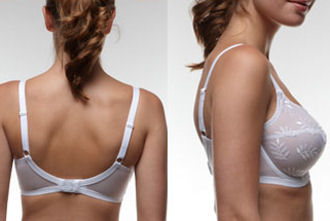
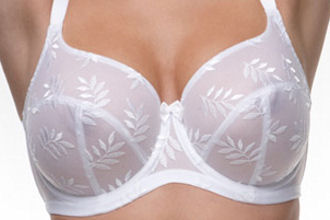
Correct: The back of the bra is level with the front. The underwire is sitting agains the chest throughout the entire length.
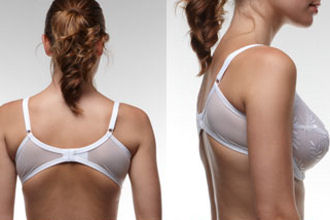
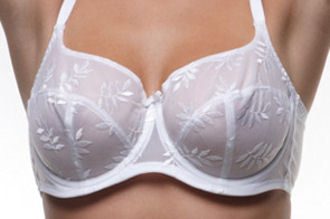
Incorrect: The bra band is too big, if the bra back rides up. If the band rides up in the back, the breasts will slip under wires when you raise your arms. A too loose bra band does not provide support and weight of the breasts is supported by the shoulder straps.
The right cup size
Second, check that the cup size is correct: the breast should not overflow from the top edge of bra cup or under the armpit and the wires should sit against the chest
If there is any bulging on the top or sides, the cup size is too small. The breasts simply do not fit into the cups. If you have to shake or adjust the breasts into the cups during the day, the cup size is too small. Even if you manage to fit the breasts momentarily. Try at least one cup size larger bra.
The wires should sit against the chest the entire length. The wires should encase the whole breast tissue. None of the breast tissue should not slip beneath the wires. The wires and the bra´s center panel should lie flat againts the breastbone. The wires should not poke out in the front.
Try a smaller cup size, if the bra cups aren´t filled out. However, if there's empty space or loose fabric in the tip of the cups where the nipples should be, the cup size usually is too small rather than too big as one might think at first. When the cup size is too small, the large breast tissue simply fills up the cup from the sides, so that tip of the cup remains empty. The breast will probably bulge over the sides, front or under the wires.
When the bra size is the correct, the wires are unnoticeable, they don´t pinch or chafe.
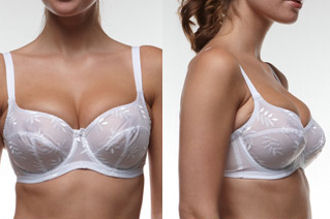
Incorrect: The cup size is too small, if the breast overflow from top or side. The cup size is too small, if you have to adjust and shake your breasts into the cups several times a day. Try one to two cup sizes bigger bra.
Properly adjusted shoulder straps
Incorrectly adjusted straps can slip or chafe. If the straps are slipping off the shoulders, the cup size is probably too small and the band too loose. 90% of the bra support should come from the band and the shoulder straps should only support 10% of the weight of the breast.
Too loose bra band can cause shoulder straps to sink in, when breast weight is for the most part supported by shoulder straps. The breasts should be supported primarily by the band around the rib cage, rather than by the shoulder straps. We recommend going down a band lenght.
Due to too loose band lenght, the majority of the weight of the breast remains on the shoulders, leaving red marks or causing shoulder or back pains. If the right bra size doesn´t fix this problem, switch to a different bra model, with wide shoulder straps. In general, bra designed to big busted women have wide, reinforced straps for support and comfort. Pain of the straps digging into shoulders may also be relieved with shoulder paddings. These paddings are usually made of silicone or fabric.
Many women attemp to correct too small a cup size by loosening the straps to avoid the "double breast" phenomenon, where the breasts bulge at the top of the cups. This may lead to loss of all intented support of the bra. To rectify, check the band lenght once more and try a bra that is 1-2 cup sizes larger and tighten the straps to a comfortable tension.
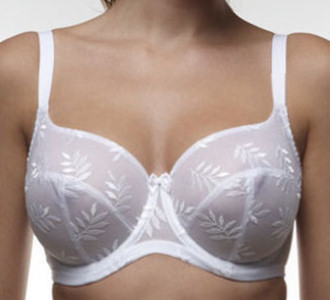
Correct: Cup size and band are correct, when the breast fits into the cups without bulging and bra sits against the chest. The properly adjusted shoulder straps do not sink in or press and leave red marks on the shoulders.
There are differences in bra styles
Also remember, that the sizes of different manufacturers differ somewhat from each other. Try brassiere in different sizes, if you feel that the bra might not be satisfactory fit. If the manufacturer or bra model is new to you, you can always order 2-3 different sizes and compare them at home.
Our product information will tell you whether the bra is sold in EU or UK-cup sizes. We try to tell in the product descriptions if the sizing somewhat different from expected.
When you contact our customer service for tips on product fit, please tell us beforehand some of the manufacturers and sizes you are currently using. Send also under the bust and around the chest measurements and if there are any fit issues with your current brassiere.
D-cup illusion can be misleading
Too often we hear women say, "I have always been a B-cup" or "I can't be a D-cup, it's so huge." In bra sizes, the letter does not always mean volume of the same size cups. 65D and 90D, for example, are quite different in size, although both are D-cup sizes. Cup size - or rather the letter the cup size - tells the volume of the cup in proportion to the band size. Holding on to a cup size is not worth it. Size varies very easily over the years, and especially if there is any changes in weight, pregnancies, new exercise regimen or a change of diet. There is also size variations between manufacturers. It's always important to try on the bra before the final purchase decision.
Unfortunately many size guides say erroneously that cup sizes in brassiere are only A, B, C, and D. In addition, this delusion is fueled by size charts, stating, "A small, normal B-, C-major, D-large" and then the cup sizes run out. This gives the impression that all women should fit in the range of A to D cup sizes and D cup is already something quite huge and it is the largest available.
Such advertising will ofter lead young girl to get a larger band size, when really should increase the letter of the cup size. For example, 75D bra is small, next one might try a 80D and then 85D, when you actually should have increased the cup size instead of bigger band size. From 75D you should first move to a 75DD or E cup and then 75F. The volume of the cup is basically the same in sizes 85D and 75F, which are sister sizes, but important support for a large bust is lost when the bra band is too large.
Fortunately alternative bra models and sizes are found. The bra size doesn't end at D-cup after D-cup in EU-sizing we have least E, F, G, H, I, J, K, L and M - and even larger sizes are available. In UK-sizing D-cup is followed by DD, E, F, FF, G, GG, H, HH, J, JJ, and K. Also, KK and L-cup sizes are available on some models.
